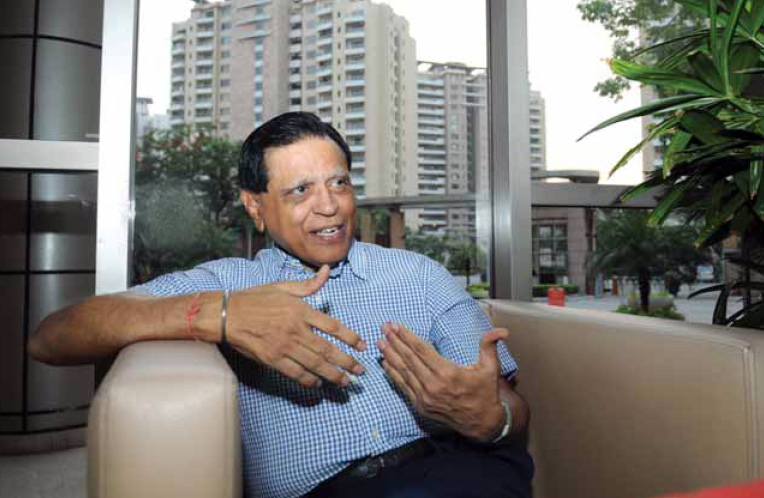ANIL Kumar Lakhina, a 1974-batch Maharashtra cadre IAS, could never imagine that a reorganisation-cum-clean up drive in Ahmednagar collectorate he carried out for nine months in 1982, would lead to coinage of appellations like ‘Lakhina experiment’, ‘Lakhina Pattern’ and ‘Lakhina model’.
He never thought that the drive would make him a role model for the entire governance machinery in the country, from Jammu & Kashmir to Kerala and right up to the top of the executive pyramid—Prime Minister of India—and even fetch him a Padma Shri from the President of India.
According to Lakhina, his limited purpose in initiating the drive was to improve the responsiveness of the government to the requests and needs of members of the public and to make the district administration under him people-oriented and corruption-free. His effort was directed to finding answers to questions like, why common man has been reduced to paper and why paper is a number?
The mammoth exercise, which involved relocating 3 lakh files, over 200 Class I, Class II, Class III and Class IV staff, rearranging cupboards, almirahs, tables and chairs, weeding out files weighing 100 tonnes and converting the record room into a sacred place a la kitchen in a home where nobody would enter with his shoes on.
Lakhina, now 68, recollects that the first thing he did was to send a team of officers and senior clerks to Satara district, where then Collector VP Raja had attempted to improve the working conditions and evolve a system of better contact with the public. Next, he studied all the laid-down procedures.
A study was made about the kind of visitors who turned up in 160-year-old Collectorate barracks to get their works done. The visitors were classified into three broader categories—MLAs, MPs, MLCs, Chairmen of various co-operative units and political party leaders; members of business community, politicians from taluka, friends and colleagues of the senior officers or non-officials and ex-MLAs; sarpanches, members of panchayat samities, students, employees, citizens and villagers, etc. The first category would turn up to pursue development projects and use its influence to get a particular license. The second would want to check about clearance of their bills. The third would come to enquire about land records, encroachments on land, right of way, conversion of land use, irrigation rights, collection of birth, succession, attestation certificates, police protection or excesses and complaints against other departments.
Lakhina engaged Ahmednagar-based Kale-Mutha Consultants and JJ School of Arts, Mumbai, for architectural advice. Clerks were asked to sit in straight rows with each facing the back of the other to avoid gossiping during office hours. Special enclosures with glass panes were made for supervisory officers so that they could keep an eye on their clerical staff.
To regulate clerk-public contact, a counter and token system was introduced for renewal of licenses, issue of certificates, inquiries on fair price shops and police patils. Lakhina says he drew the token system idea from the State Bank of India, where he had worked as Probationary Officer (PO) before joining the civil services. He quit the banking service because, he claims, it trained him to be an accountant.
Lakhina then ordered demystification of office procedures by writing them down on leaflets and pamphlets in simple vernacular language. The leaflets, distributed free of charge, were available for fair price shops, licenses for arms, selling sugar, grains, kerosene, running a cinema, conversion of land use and grant of land for residential, commercial and industrial purposes.
This was followed by arranging paper bundles systematically and cataloguing all files compilation and year-wise. Desk manuals were prepared to make sure that even in the absence of a dealing clerk, work does not stop. The Collectorate brought about improvement in working condition of employees, dust proofed the record room and arranged for training of junior staff by senior staff. The audit of record room produced 10 truckloads of useless paper, which fetched the state treasury `26,000 from sale.
WITHIN months, the model became a major attraction for national and vernacular media, State governments and the Centre. So much so, six other districts of Maharashtra and Mantralaya (headquarters of Maharashtra government) replicated the model and states like Kerala, Jammu & Kashmir, Tripura, Uttar Pradesh, Andhra Pradesh and Delhi-based Institute of Public Administration (IIPA) sent their representatives to Ahmednagar to study what came to be known by now as ‘Lakhina pattern’.
The Film and Television Institute of India (FTII) Pune, shot a documentary on the experiment and filmmaker Basu Bhattacharya and PL Deshpande, writer known as ‘Maharashtra’s beloved personality’, visited Ahmednagar to explore the initiative.
In May 1984, when Maharashtra government decided to set up an institute to streamline district-level and grassroots administration, it chose Lakhina for the job. The institute—Maharashtra Institute of Development Administration—has since been rechristened Yashwantrao Chavan Academy of Administration (YASHDA).
Exactly a year later, the then Prime Minister Rajiv Gandhi wrote to all State chief ministers to send their reputed district collectors for short term training courses in Lakhina model to the MIDA. Subsequently, in 1986, government of India awarded Lakhina with Padma Shri award. He headed the MIDA for two–and-a-half years.
 Lakhina believes what made him a leader in Ahmednagar was not just rearranging of the Collectorate. His empathy towards Collectorate employees and interest in social activities like theatre and exhibitions also contributed to this.
Lakhina believes what made him a leader in Ahmednagar was not just rearranging of the Collectorate. His empathy towards Collectorate employees and interest in social activities like theatre and exhibitions also contributed to this.
But the leadership quality of the only son of late GD Chandan, a highly-qualified officer of the Press Information Bureau (PIB), and homemaker Prakash Rani, was on display even in Bhandara where he cut his teeth as Supernumerary Assistant Collector.
Once he was assigned the job of organising a cataract operation there. In those days, cataract operations were week-long affairs. The operations were to be performed in a school building, where to his dismay, he found there was no water for disinfecting the place. He visited neighbouring villages to collect large utensils for transporting water. “I was forced to innovate because I was the leader on the ground. A crisis makes a leader,” he reminisces.
IN March 1991, during the period of India’s economic liberalisation, Lakhina was made Exports Commissioner under the Union Ministry of Commerce. He played a major role in rewriting the country’s import and export policies.
Between March 1995 to March 1999, he restructured manufacturing processes in pharmaceutical set ups as Commissioner, Food and Drug Administration. In the next about four years, he, as Vice-Chairman of City and Industrial Development Corporation (CIDCO), oversaw the development of Navi Mumbai and prepared the blue print of India’s first Special Economic Zone (SEZ) there.
Lakhina is credited with planning India’s first sea link—Bandra-Worli Sea Link—and Mumbai-Pune expressway when he was the Managing Director of Maharashtra State Road Development Corporation (MSRDC). Further, under his chairmanship, the Rural Electrification Corporation (REC), a public sector finance company, doubled its sanctions, disbursements and operational profits and debuted on the Bombay Stock Exchange (BSE) and the National Stock Exchange (NSE). He retired in February 2008 from the REC.
Lakhina regrets all his achievements got eclipsed by Ahmednagar experiment. “My grudge is why should I be judged by one achievement alone?” he asks.
Since his retirement from the civil services, Lakhina has served as Director of a number of private companies. In between, he formed the Forum for the Advancement of Solar Thermal (FAST), an advisory company which worked on addressing policy, commercial, development and operational challenges in promoting the use of solar thermal power in India.
“I wanted to do something new and more challenging,” he explains his shift to the private sector. Currently, this father of two sons (both run their own businesses), serves as Chairman of Al Aftaab, a Dubai-based company on renewable energy.
Of his 42 year-long career in public and private sectors, Lakhina has spent about half in managing energy companies. Not a small achievement considering that his maternal grandfather Mulkraj Mehta, owned a powerhouse, first in Moga and later in Narela, before Independence. His parents migrated from Pakistan during the partition and he, the only civil servant in his family, got into civil services to train to be an officer rather than an accountant.
As told to Narendra Kaushik





























































